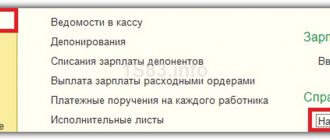General personal income tax
As a general rule, personal income tax is paid not at the expense of the employer, such as, for example, insurance premiums from employee salaries, but at the expense of the employee, by subtracting the tax from his income. The standard rate for residents of the Russian Federation for official employment is 13%, and for non-residents of the Russian Federation - 30% (with the exception of highly qualified specialists, for whom the personal income tax rate is 13%).
Important! The Government of the Russian Federation plans to reduce in 2022. The personal income tax rate for non-residents is up to 13%.
The tax is initially withheld from the employee’s income and then transferred to the state budget. At the same time, transfer of personal income tax is possible only after the income is paid to the employee - issued in cash through the cash register or transferred to a bank account.
Violations of personal income tax legislation include the following important points:
- the employer assumes the burden of personal income tax, that is, transfers his own money, and not withheld from the individual’s income (if he transfers the tax before the payment of income);
- the employer shifts the responsibility of calculating and remitting tax to the employee himself. The company is a tax agent for personal income tax, and therefore it must directly calculate, withhold and transfer the tax to the state budget. The employee receives a salary or other income minus the amount of calculated and withheld tax.
The timing of personal income tax transfers depends on what type of income the employee receives. In some cases, the tax must be transferred no later than the next day after the payment of income, for example, payment for labor under an employment or civil service contract. In other cases, personal income tax must be transferred before the end of the month in which the income was paid, for example, for vacation pay or sick leave.
How to use the calculator
In order to make the calculation, you need to enter the amount of wages for the month, as well as the amount received cumulatively for the employee since the beginning of the year. It is necessary for calculating taxes on funds, and it is also a condition for applying deductions for an employee.
For 2015, the maximum value of the total salary for applying deductions is 280 thousand rubles. Also, reduced interest rates have been established for the Pension Fund of the Russian Federation, if they exceed 711 thousand rubles, and for the Social Insurance Fund - 670 thousand rubles. In 2016, these figures increased and amounted to: for the Pension Fund of Russia 796 thousand. rub., and for the Social Insurance Fund - 718 thousand rubles, the amount of the maximum salary for applying deductions in 2016 is 350 thousand rubles.
Next, you need to enter information about standard deductions. If any of them does not depend on the maximum salary of 350 thousand rubles, then put it in “deductions without restrictions.”
You can read about the interest rates of the Pension Fund, Social Insurance Fund and Federal Compulsory Medical Insurance Fund, as well as the calculation procedure in the article on the procedure for calculating salaries.
In order to calculate the total taxes paid by the employer and employee, you have two options:
- You can enter the amount of wages before taxes are calculated on it, all amounts will be calculated automatically, including the amount of wages that will be due to the employee after taxes are paid.
- You can enter the amount of salary that the employee receives in person, after which the calculator will calculate all taxes in reverse order and show the amount of salary that needs to be calculated based on the amount received in hand. At the same time, do not forget to take into account deductions if they are provided to him. The calculation will also be adjusted to these amounts automatically.
Amounts not subject to personal income tax
According to Art. 217 of the Tax Code of the Russian Federation, some income received by individuals is not subject to personal income tax. Their list is very extensive, but the most common are, for example, the following:
- state benefits (except for temporary disability benefits), for example, for pregnancy and childbirth, child care up to 1.5 years;
- amounts for damages in connection with injury or damage to health;
- cash reimbursement for utilities or fuel;
- cost of food in kind;
- expenses for improving the professional level of an employee;
- costs for the employee to perform work duties, for example, travel expenses;
- daily daily allowance within 700 rubles. for business trips in Russia and within 2,500 rubles. for business trips abroad;
- severance pay, average monthly earnings within 3 average monthly earnings or 6 average monthly earnings (if the organization is located in the Far North and equivalent territories);
- financial assistance from the employer up to RUB 50,000. for each child at the birth or adoption of a baby;
- gifts or material assistance received from the employer - no more than 4,000 rubles;
- benefits in connection with the death of a close relative, etc.
How to count
There are various methods for calculating the final bonus. Here is how the thirteenth salary is calculated in budgetary institutions and commercial enterprises:
- Fixed value. In this case, remuneration is determined only for some employees, and its amount is set within varying limits at the discretion of the employer.
- Share of salary. The amount is differentiated as a percentage according to certain criteria.
- Average annual earnings. Formula for calculating the 13th bonus, knowing the average for the year:
Pzp.sr.g. + Pstazh,
where Pzp.sr.g. - bonus based on average annual income,
Experience is a monetary remuneration provided for length of service.
If the option of paying 13 salaries in a clinic or other institution is a fixed amount, then incentives to specialists are paid based on the amount established by the company. Employees recognize its size by their position or work unit: the administrative staff is assigned one payment, and, for example, a different bonus salary is provided for service personnel. Comments on this method of calculation are indicated in the collective agreement and bonus regulations in force in the institution.
If incentives are defined as a percentage of employee salaries, then here is an example of how the 13th salary is calculated for different options:
Option 1. The total amount of salaries for the institution for the entire calendar year must be divided by the total number of working days for the entire year, and the resulting value multiplied by 22 working days.
Option 2. The total annual salary of an individual employee is divided into 12 months, the result is his bonus.
An example of how to calculate the 13th salary based on annual income: Ivanov I.I. received 863,000 rubles for the year, 13th salary = 863,000 / 12 = 71,916.67 rubles.
Option 3. The thirteenth salary is calculated as a percentage of the salary. The accounting policy specifies a certain percentage for the incentive payment at the discretion of the manager. The salary is then multiplied by this percentage and the bonus is calculated.
Example of calculation: salary of Alexandrova A.A. - 35,000.00 rubles, the accounting department received an order from the manager to accrue employee 13 a salary in the amount of 110% of the salary for high performance results. As a result, Alexandrova A.A. will receive 35,000 × 110% = 38,500 rubles as an incentive salary at the end of the year.
Let's give another example - calculating 13 salaries in the metro: in the metro, bonuses are calculated according to special rules. The annual incentive formula for metro employees is as follows:
amount for annual bonus × coefficient × length of service coefficient.
The individual amount for the bonus is indicated on the employee’s payslip.
In addition, coefficients are applied to the salaries of some metro employees: wage coefficient 13 for the metro is determined depending on length of service and a fixed number of kopecks (6.5). Experience coefficients for the metro:
- 1 year - 1;
- 2 years - 1.2;
- 3 year - 1.4;
- from 4 to 6 years - 1.6;
- from 6 to 10 years - 1.8;
- from 10 years - 2.0.
Experience of Vasiliev V.V. in the metro - 10 years (coefficient 1.8). The amount for the 13th salary is 950,000 rubles. Taking into account the coefficients, the annual premium is calculated as follows: 950,000 × 0.065 = 61,750 rubles. Now we multiply by the length of service coefficient: 61,750 × 1.8 = 111,150 rubles. This is the employee's annual bonus.
The accountant has the right to calculate the thirteenth salary depending on the shares of employees in the bonus fund.
Example: 70,000.00 rubles were allocated for bonuses for the company’s economic department. The division employs the head of the economic department, Ilyin I.I. and leading economist Fedorov F.F.
Employee Salary/share Experience/share Average share Grand Total 90 000,00/1 25 years/1 Ilyin I.I. 50 000,00/0,55 15 years/0.6 0,57 Fedorov F.F. 40 000,00/0,45 10 years/0.4 0,43 13 the salary for each employee will be:
- Ilyin I.I. = 70,000.00 × 0.57 = 39,900.00 rub.;
- Fedorov F.F. = 70,000.00 × 0.43 = 30,100.00 rub.
Tax deductions
Tax deductions are amounts based on which the tax base is reduced. Tax deductions can be standard, social or property. Some of them can be obtained both through the employer and through the tax office, while others can only be obtained through the Federal Tax Service.
The most common is the standard deduction for children. As a rule, the right to receive them is associated with a minimum package of documents provided by the taxpayer. The deduction depends on how many children an individual has and who they are (parent, adoptive parent, guardian, etc.).
Social deductions are mainly received for expenses on education or treatment, both for yourself and for your immediate family. Property deductions are associated with the purchase of real estate - both in cash and by concluding a loan agreement.
The provision of almost all tax deductions is based on the fact that there is a specific limit, if exceeded, the taxpayer loses the right to use them. For example, for standard deductions for children, the limit is 350,000 rubles. total income for the period starting from the calendar year. For the property deduction when purchasing real estate, the deduction is 2 million rubles.
Payroll calculation without a calculator
Let's look at how to calculate your salary per day without a calculator. If an employee worked for a full month, regardless of the number of working days, he is due to be paid the amount established by the labor (collective) agreement. If an employee has worked an incomplete period (hiring or dismissal, sick leave, business trips, vacation or absence for other reasons), salary calculation is carried out according to the formula:
The Labor Code of the Russian Federation establishes that the employer is obliged to make payments for the period worked at least twice a month, on established dates. The calculation for each half of the pay period is made taking into account the time actually worked, and it is impossible to formally approach the payment for the first half. When calculating wages based on salaries for the first half of the period, it is more convenient to use a calculator.
Thus, if an employee has fully worked the pay period, and the first and second halves account for the same number of working days, then he must be paid in equal installments.
It is important to remember that personal income tax is transferred to the budget only once - at the final settlement. If you pay the full amount for the first half, excluding personal income tax, then at the end of the month sometimes a situation arises when the employee has nothing to withhold tax from. The most applicable method is in which wages for the first half of the period are calculated minus personal income tax, but tax deduction and accrual are not reflected.
Personal income tax in 1C
When calculating personal income tax in the 1C:ZUP program, you must make the following settings:
- check that standard deductions are applied on an accrual basis during the tax period;
- analyze whether the income codes are indicated correctly, since they will be reflected in personal income tax reporting;
- set up personal income tax taxation for each type of accrual and deduction.
Personal income tax must be calculated for each amount of actually accrued income for each month separately. Tax is calculated by various documents depending on the type of income - vacation, sick leave, payroll, etc.
When closing the salary month, the document “Accrual of salaries and contributions” will reflect all amounts of income, deductions provided, as well as calculated and withheld taxes. This information is reflected in both accounting and tax accounting, that is, it ends up in the appropriate tax accounting registers.
Based on this information, reporting is generated to the Federal Tax Service, for example, certificates in form 2-NDFL or calculation of 6-NDFL. In the future, you can take advantage of the possibilities of transferring data directly from the program through the 1C: Reporting service, which is included in ITS PROF.
Salary based on salary: documentation when calculating on a calculator
In order for an accountant to determine how to calculate wages based on salary, he needs to have the following data:
- An order to hire a specialist with a salary in accordance with the staffing table. Since the Labor Code of the Russian Federation contains a reference to the staffing table, often when checking by the labor inspectorate, the absence of this document is regarded as a violation.
- The official salary established for a given employee, the fixed amount of which is determined by an employment or collective agreement.
- The number of days worked by an employee in a calendar month is documented in a time sheet. The unified form of this document is mandatory for public sector organizations and approved by Order of the Ministry of Finance of Russia dated March 30, 2015 No. 52n, for other business entities unified forms, incl. the work time sheet (form T-13) and the work time sheet and calculation of wages (form T-12) are not mandatory for use (Law “On Accounting” No. 402-FZ of December 6, 2011). If an organization that is not a government organization decides not to use unified forms, it enshrines in its local regulations independently developed forms of documents for recording working hours.
When paying for the month worked, the employee must provide a pay slip, the form, procedure and frequency of submission of which the organization develops independently.
Example of personal income tax calculation
Let's consider a specific example of calculating personal income tax for December for one employee.
Input data:
| Index | Meaning |
| Salary | 40,000 rub. |
| Compensation for harmful working conditions (from salary) | 4% |
| 1 child (full-time student) | age 20 years |
| 2 child (disabled) | age 10 years |
| 3 child | age 3 years |
| New Year's gift | 7,000 rub. |
| Vacation pay for vacation in January | 15,000 rub. |
| Withholding under a writ of execution for a loan | 25% |
The calculation of personal income tax and salary received by an employee in person will look like this:
- Pay including compensation will be equal to:
40,000 + 40,000 * 4% = 41,600 rub.
- The tax base, taking into account deductions, will be equal to:
41,600 + 3,000 (gift limit - 4 thousand rubles) + 15,000 - 1,400 (deduction for 1 student child) - 12,000 (deduction for 2 disabled children) - 3,000 (deduction for 3 children) = RUB 43,200
- The tax rate at 13% will be equal to:
43,200 * 13% = 5,616 rubles.
- The amount of deduction under the writ of execution will be equal to:
(43,200 - 5,616) * 25% = 9,396 rubles.
- The amount that the employee will receive in hand for December:
(41,600 + 7,000 + 15,000) - 5,616 - 9,396 = 48,588 rubles.
Correct calculation of personal income tax will allow companies to avoid questions from regulatory authorities and the application of penalties to them. The 1C program provides the ability to automatically calculate taxes on employee income. If the software is updated correctly and in a timely manner, the user is guaranteed the calculation of personal income tax in strict accordance with the norms of the current tax legislation.
Still have questions? Order a free consultation with our specialists!
Did you like the article?
Want to receive articles like this every Thursday? Keep abreast of changes in legislation? Subscribe to our newsletter
How to calculate income tax from money to be issued
Sometimes employers cooperate with individuals semi-officially. That is, they pay extra salary “in an envelope”. The law does not approve of such actions, because many organizations avoid fulfilling legal obligations. Then two questions arise: how to calculate personal income tax from the amount in hand and the accrued salary?
To calculate, use one of two formulas:
Salary – salary from which income tax is calculated;
ZP – cash transferred in person.
Example 2 Sales manager Vishnevskaya, working in, is paid 21,500 rubles per month by agreement with the employer. How to calculate personal income tax and the amount on which tax is withheld?
Solution:
CJSC Edelweiss pays Vishnevskaya a salary of 24,712 rubles, from which 3,212 rubles. contributes to the budget.
An organization may employ employees who have financial obligations that do not reduce the NB. For example, when deducting alimony, personal income tax is withheld not from the amount handed out, but from the accrued salary. According to Art. 81 of the RF IC, their size is:
- 1/4 of earnings - for one child;
- 1/3 – for two children;
- 1/2 – for three or more children.
Example 3 An employee of Antey LLC Orlov received a salary for June - 35,977 rubles. He is divorced from his wife. By court decision, he is obliged to pay alimony for his minor daughter (25% of income). The tax base, taking into account the deduction for a child, will be:
| Period | Amount, rub. | Personal income tax, r. |
| January-May | 172 885 | 22 475 |
| January June | 207 462 | 26 970 |
How much money should be given to Orlov?
Solution:
The share of alimony will be: 35977 x 25% = 8994.25 rubles.
Calculation of the taxpayer’s personal income tax: 26970 – 22475 = 4,495 rubles.
Cash issued to Orlov: 35,977 – 8994.25-4,495 = 22,487.75 rubles.
Antey LLC must pay Orlov 22,487.75 rubles.
Taxation of 13 salaries
The incentive payment at the end of the year is subject to taxes and insurance contributions according to the general rule. This means that personal income tax is taken from it in the amount of 13%. Here's how to calculate the tax from the 13th salary: 13% multiplied by the calculated amount of bonus accruals. In addition, the accrued amount is subject to all types of insurance contributions - for compulsory pension and health insurance, contributions for temporary disability and in connection with maternity, for insurance against occupational diseases and accidents.
All taxes and insurance premiums are calculated directly in the month of the thirteenth salary. Personal income tax is withheld at the time of payment of incentives at the end of the year.






